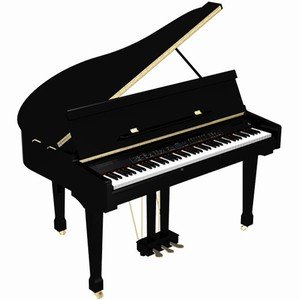ITA
LA VOCE DEI SENTIMENTI
Gli artisti romantici, in particolare i tedeschi, si interessano alla musica strumentale e a essa affidano l’espressione dei sentimenti. Lo strumento che domina l’Ottocento il pianoforte, perché è dotato di una grande estensione e permette una grande varietà di sfumature dinamiche (dal pianissimo al fortissima), impossibili da produrre con il Vecchio clavicembalo, che ora scompare definitivamente.
Il pianoforte a coda
Quando Bartolomeo Cristofori da Padova, nel 1711, costruisce il primo pianoforte, lo chiama clavicembalo col piano e col forte o fortepiano,proprio perché la sua principale novità rispetto al clavicembalo consiste nel produrre suoni di varia intensità. Grazxe all'invenzione dei martelletti che battono le corde, la forza con cui l’esecutore preme il tasto cambia l’intensità dei suoni. ll pianoforte a coda poggia su tre piedi e ha la cassa a forma di arpa coricata orizzontalmente; ha il suono più potente di altri tipi di pianoforte e risponde meglio a tutte le esigenze di una buona esecuzione. Vediamo le parti principali di questo strumento importantissimo:
la cassa, parte esterna di legno che costituisce l’involucro dello strumento; '
la cordiera, che comprende l’insieme delle corde di acciaio e la relativa tavola di ghisa, necessaria a mantenerle tese, ad accordarle e a dare loro risonanza; '
la meccanica, complesso sistema di leve in legno che trasmette il movimento dai tasti ai martelletti che battono le corde; ‘
la tastiera, che comprende di solito 88 tasti, di cui 52 bianchi e 36 neri, con un'estensione ne di oltre sette ottave;
i due pedali, cui poi se ne aggiungerà un terzo, per variare la risonanza delle corde.
Il pianoforte verticale
Rispetto al pianoforte a coda, il pianoforte verticale occupa meno spazio. La cassa che contiene le corde, infatti, è disposta verticalmente anziché orizzontalmente.
Ha una potenza sonora minore e, nelle case e nelle scuole, e
più utilizzato del pianoforte a coda, perché meno ingombrante e molto più economico. Anch’esso si presta a un’ampia varietà di generi musicali.
ING.
THE HEART OF FEELINGS
Romantic artists, especially the Germans, are interested in instrumental music and entrust it with the expression of feelings. The instrument that dominates the nineteenth-century piano, because it has a large extension and allows a great variety of dynamic nuances (from the top to the strongest), impossible to produce with the Old Harpsichord, which now disappears decently.
The grand piano
When Bartolomeo Cristofori from Padua built his first piano in 1711, he called him a harpsichord with the piano and with the strong or strong piano, just because his pnncrpale novelty compared to the harpsichord is to produce sounds of varying intensity. Grazxe to the invention of the hammer striking the strings, the force with which the performer presses the button changes the intensity of the sounds. The tailor's piano rests on three feet and has the harp-shaped chest horizontally lying; has the most powerful sound of other types of piano and responds better to all the requirements of a good performance. We see the main parts of this very important tool:
the chest, the outside of wood that forms the instrument casing; '
the cordier, which includes the whole of the steel strings and the corresponding cast iron board, which is necessary to keep them tight, to match them and to give them resonance; '
the mechanics, a complex system of wooden levers that transmits the movement from the keys to the hammer strings that strike the strings; '
the keyboard, which usually includes 88 keys, of which 52 are white and 36 black, with an extension of more than seven octaves;
the two pedals, which will then be added to a third, to vary the resonance of the strings.
The vertical piano
Compared to the grand piano, i The chord containing the strings, in fact, is arranged vertically rather than horizontally.
It has a lower sonic power and, in the case and its mats, and
the most used of the grand piano, because it is less bulky and much cheaper. It also lends itself to a wide variety of music genres.

Nice to meet you, @hxframc! Welcome to the Steemit Community, wish you good luck and a good start, ive send you a small tip and followed you, hope you have an amazing day! :)
thank you so much!